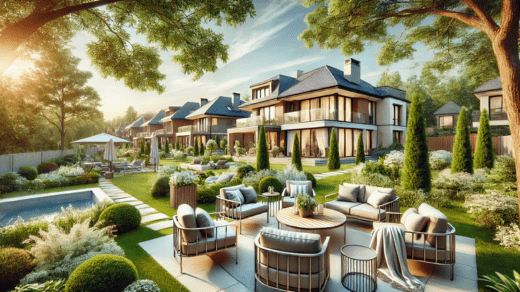When it comes to outfitting your garden with stylish, durable furniture, the materials you choose play a crucial role in ensuring both the longevity and aesthetic appeal of your outdoor space. Garden furniture materials need to withstand the elements, from rain and wind to the intense summer sun, while still providing comfort and style. With a wide variety of materials available, it can be overwhelming to know where to start. This guide will help you choose the best outdoor materials for your garden furniture, ensuring you make an informed decision for both durability and design.
1. Why Material Selection Matters
The right garden furniture materials can make a huge difference in the performance, maintenance, and lifespan of your outdoor pieces. Outdoor furniture is exposed to the weather year-round, and the materials you choose should be able to handle exposure to moisture, sunlight, and fluctuating temperatures. Additionally, comfort and style should not be sacrificed for durability—your furniture should reflect your personal aesthetic and provide a comfortable place to relax and entertain.
2. Top Materials for Garden Furniture
Here’s a breakdown of the most popular materials used in outdoor furniture and their unique benefits:
1. Aluminum: Lightweight and Rust-Resistant
Aluminum is a popular material for garden furniture because it’s lightweight, durable, and resistant to rust. It’s an excellent choice for those who need furniture that’s easy to move around or for areas with high humidity. Aluminum furniture requires minimal maintenance, making it a low-hassle option for outdoor living spaces.
- Benefits:
- Resistant to rust and corrosion
- Lightweight and easy to move
- Low maintenance and easy to clean
- Available in various designs, from modern to classic
- Drawbacks:
- Can get hot in direct sunlight
- May be less comfortable without cushions
2. Teak: Timeless and Weather-Resistant
Teak wood is a classic material known for its strength and resistance to moisture, making it perfect for outdoor furniture. It contains natural oils that protect it from decay, insects, and water damage. Over time, teak develops a beautiful silver-gray patina, but it can be maintained with occasional oiling to preserve its warm, golden hue.
- Benefits:
- Natural weather resistance (doesn’t rot or warp easily)
- Beautiful appearance that improves with age
- Comfortable, with no need for cushions
- Long-lasting and durable
- Drawbacks:
- Requires occasional maintenance (oiling) to maintain color
- Can be expensive compared to other materials
3. Wicker and Rattan: Stylish and Versatile
Wicker and rattan are traditional materials that are often woven into intricate designs to create stunning garden furniture. Today, many wicker and rattan pieces are made with synthetic fibers (such as polyethylene or resin) that mimic the look of natural wicker while offering enhanced durability and resistance to the elements.
- Benefits:
- Stylish and versatile; can fit many outdoor styles
- Comfortable without the need for cushions
- Lightweight yet sturdy
- Easy to clean and resistant to sun, rain, and snow
- Drawbacks:
- Synthetic rattan can degrade over time if exposed to extreme temperatures or UV rays
- May lose its elasticity and shape with age
4. Cast Aluminum: Sturdy and Elegant
Cast aluminum is another popular material for high-quality garden furniture. Unlike standard aluminum, cast aluminum is molded into more intricate shapes, giving it a more decorative and elegant appearance. It is still lightweight but offers greater strength, making it suitable for more elaborate designs such as chairs with arms and ornate tables.
- Benefits:
- Strong and durable
- Rust-resistant
- Elegant designs with intricate patterns
- Low maintenance
- Drawbacks:
- Can be heavier than regular aluminum
- May get hot under direct sunlight
5. Steel: Strong and Robust
Steel is one of the strongest materials used in outdoor furniture, making it perfect for heavy-duty pieces that need to withstand rough conditions. While steel garden furniture is generally heavier, it’s extremely durable and ideal for areas with high winds or for use in commercial spaces.
- Benefits:
- Extremely strong and durable
- Available in sleek, modern designs
- Suitable for larger or commercial outdoor spaces
- Low-maintenance if treated for rust resistance
- Drawbacks:
- Can rust if not properly maintained
- Heavier and harder to move than lighter materials
6. Plastic and Resin: Affordable and Low-Maintenance
Plastic and resin furniture is a budget-friendly and low-maintenance option for garden furniture. It’s lightweight, resistant to weather conditions, and easy to clean. Resin, in particular, is known for its durability and comes in a variety of styles, often mimicking more expensive materials like wood or wicker.
- Benefits:
- Affordable and available in a variety of styles
- Lightweight and easy to move
- Resistant to the elements (doesn’t fade or crack easily)
- Low-maintenance, just requiring occasional cleaning
- Drawbacks:
- Can lack the aesthetic appeal of more natural materials
- Less durable than wood or metal in extreme conditions
3. How to Choose the Best Material for Your Garden Furniture
When choosing the best material for your garden furniture, there are several factors to consider:
Climate
The weather in your area plays a significant role in determining the best material for your furniture. If you live in an area with a lot of rain, teak, aluminum, or resin might be your best bet, as they are resistant to moisture. For hot, sunny climates, wicker or metal can handle the heat and won’t fade as easily.
Maintenance
Consider how much time you want to spend maintaining your furniture. If you prefer a low-maintenance option, aluminum, resin, or plastic may be ideal. These materials require minimal upkeep and are perfect for people who don’t want to deal with frequent cleaning or treating.
Aesthetic
The style of your garden plays a significant role in your material choice. Teak offers a traditional, rustic look, while metal and resin can provide a more modern or minimalist aesthetic. Consider how the material will complement your existing outdoor decor.
Budget
Your budget will also dictate your material choice. Plastic and resin furniture are generally the most affordable, while teak and cast aluminum tend to be on the pricier side. However, keep in mind that more expensive materials often provide greater durability, making them a worthwhile investment in the long run.
Some gardens and luxury houses in Bistritsa region allow bigger furniture.
Selecting the best garden furniture materials is essential for creating a comfortable and stylish outdoor space that stands the test of time. Whether you prioritize durability, aesthetic appeal, or low maintenance, the right material can make all the difference in the enjoyment and longevity of your furniture.
Consider the climate, maintenance requirements, and overall style of your garden when making your decision. With the right choice, your garden furniture will remain a reliable, beautiful addition to your outdoor retreat for many years to come. So it is important to choose them carefully, like you choose thermal isolation of your house.

